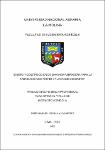Mostrar el registro sencillo del ítem
Diseño y construcción de una mesa vibradora para la fabricación de postes y placas de concreto
| dc.contributor.advisor | Rubio Valle, Alexis Enrique | |
| dc.contributor.author | Bonilla Caviedes, Jose Manuel | |
| dc.date.accessioned | 2022-12-21T00:11:10Z | |
| dc.date.available | 2022-12-21T00:11:10Z | |
| dc.date.issued | 2022 | |
| dc.identifier.uri | https://hdl.handle.net/20.500.12996/5554 | |
| dc.description | Universidad Nacional Agraria La Molina. Facultad de Ingeniería Agrícola. Departamento Académico de Mecanización y Energía | es_PE |
| dc.description.abstract | A través del presente trabajo queremos demostrar los beneficios de fabricar una mesa vibradora, considerando el enfoque sistemático de diseño de ingeniería de Pahl y Beitz, y ante la necesidad de solucionar una demanda de cercar seis kilómetros del perímetro de propiedad de un cliente, con la problemática que se le presenta con la demora de la entrega de las piezas de concreto prefabricado y los trabajos de su instalación; siendo por tanto, a nuestro criterio, el diseño y construcción de una mesa vibradora, un importante elemento a nivel de producción y de carácter innovativo para la industria nacional. En el primer capítulo desarrollamos los aspectos generales del trabajo, tales como el planteamiento del problema, los objetivos generales y específicos del presente estudio. En el segundo capítulo detallamos el marco teórico, realizando una revisión de la literatura en lo que respecta al desarrollo de las teorías para la solución de problemas en forma inventiva, los diseños de ingeniería, delimitando los de tipo conceptual, preliminar así como el de detalle o de diseño definitivo; asimismo, contiene el apartado de desarrollo de producción de concreto prefabricado en el Perú, detallando los conceptos tales como takt time, resortes de comprensión, motores eléctricos y automatización, en calidad de conceptos base para el desarrollo de la presente investigación. En el tercer capítulo, delimitamos el despliegue del trabajo, el mismo que desarrolla aspectos tales como el proceso de fabricación de cerco perimétrico de concreto prefabricado, las características del cerco perimétrico, el alcance de la investigación, las especificaciones preliminares del diseño, las características de la mesa vibradora, las características de los moldes, de tipo geométricas y dimensionales; así como de no adherencia de la mezcla al molde, así como el detalle del análisis de datos realizados. Finalmente, los capítulos cuarto, quinto y sexto presentamos los resultados obtenidos y las discusiones abordadas, las conclusiones y recomendaciones formuladas luego de haber realizado el presente estudio. | es_PE |
| dc.description.abstract | Through this study we want to demonstrate the benefits of manufacturing a vibrating table, considering the systematic approach to engineering design of Pahl and Beitz, and in view of the need to solve a demand to fence six kilometers of the perimeter of a client's property, with the problems that arise with the delay in the delivery of prefabricated concrete pieces and their installation work; being therefore, in our opinion, the design and construction of a vibrating table, an important element at the production level and of an innovative nature for the national industry. In the first chapter we develop the general aspects of the work of professional sufficiency, such as the approach to the problem, the general and specific objectives of the present study. In the second chapter we detail the theoretical framework, conducting a review of the literature regarding the development of theories for inventive problem solving, engineering designs, delimiting conceptual, preliminary, and detailed types. or final design; Likewise, it contains the section on the development of prefabricated concrete production in Peru, detailing concepts such as takt time, compression springs, electrical engine and automation, as basic concepts for the development of this investigation. In the third chapter, we delimit the development of the work, which develops aspects such as the manufacturing process of the precast concrete perimeter fence, the characteristics of the perimeter fence, the scope of the investigation, the preliminary specifications of the design, the characteristics of the vibrating table, the characteristics of the molds, geometric and dimensional; as well as non-adherence of the mixture to the mold, as well as the detail of the data analysis carried out. Finally, the fourth, fifth and sixth chapters present the results obtained and the discussions addressed, the conclusions and recommendations formulated after having carried out this study. | en_US |
| dc.format | application/pdf | en_US |
| dc.language.iso | spa | es_PE |
| dc.publisher | Universidad Nacional Agraria La Molina | es_PE |
| dc.rights | info:eu-repo/semantics/openAccess | en_US |
| dc.rights.uri | https://creativecommons.org/licenses/by-nc-nd/4.0/ | * |
| dc.subject | Postes | es_PE |
| dc.subject | Placas | es_PE |
| dc.subject | Concreto | es_PE |
| dc.subject | Arboles forestales | es_PE |
| dc.subject | Mesa vibradora | es_PE |
| dc.subject | Diseño | es_PE |
| dc.subject | Construcción | es_PE |
| dc.subject | Evaluación | es_PE |
| dc.subject | Perú | es_PE |
| dc.title | Diseño y construcción de una mesa vibradora para la fabricación de postes y placas de concreto | es_PE |
| dc.type | info:eu-repo/semantics/bachelorThesis | en_US |
| thesis.degree.discipline | Ingeniería Agrícola | es_PE |
| thesis.degree.grantor | Universidad Nacional Agraria La Molina. Facultad de Ingeniería Agrícola | es_PE |
| thesis.degree.name | Ingeniero Agrícola | es_PE |
| dc.subject.ocde | https://purl.org/pe-repo/ocde/ford#2.05.01 | es_PE |
| renati.author.dni | 07765395 | es_PE |
| dc.publisher.country | PE | es_PE |
| dc.type.version | info:eu-repo/semantics/publishedVersion | en_US |
| renati.advisor.orcid | https://orcid.org/0000-0003-2693-6141 | es_PE |
| renati.advisor.dni | 09663423 | es_PE |
| renati.type | https://purl.org/pe-repo/renati/type#trabajoDeSuficienciaProfesional | es_PE |
| renati.level | https://purl.org/pe-repo/renati/level#tituloProfesional | es_PE |
| renati.discipline | 811096 | es_PE |
| renati.juror | Vásquez Romero, Isaakk Rafael | |
| renati.juror | Alata Rey, Josué Eliezer | |
| renati.juror | Chevarría Moscoso, Margarita |
Ficheros en el ítem
Este ítem aparece en la(s) siguiente(s) colección(ones)
-
IAG-MA Tesis [20]





